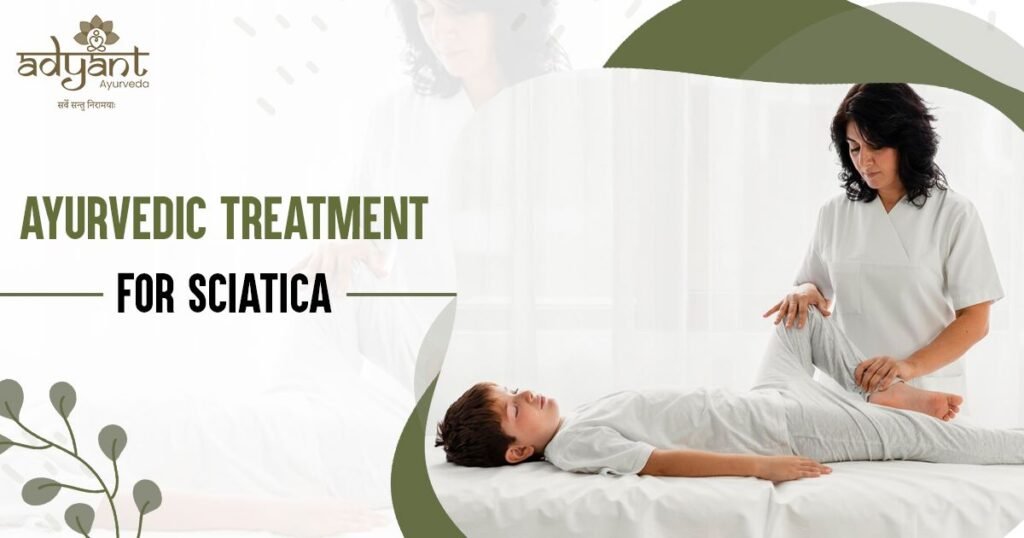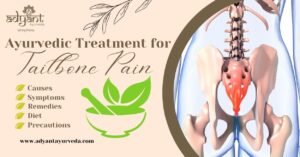Table of Contents
Toggle
Ayurvedic Treatment for Sciatica Pain: It is a common condition characterized by radiating pain along the sciatic nerve, which runs from the lower back, through the buttocks, and down each leg to the feet. The sciatic nerve is the longest nerve in the human body, and irritation or compression can lead to severe pain and discomfort.
For a free consultation with top Ayurvedic doctors for Sciatica Ayurvedic Treatment, Download our app from Play Store “AyurCare“
What is Sciatica Pain, and What is it Called in Ayurveda?
Sciatica is a pain that starts in the lower back and travels down through the hips, buttocks, and legs. It happens because the sciatic nerve, the biggest nerve in our body, gets pressed or pinched.
This pain usually happens when a part of the backbone, like a slipped disk or extra bone growth, presses on the nerve. This can cause swelling, pain, and numbness in the leg.
In Ayurveda, sciatica is called Gridhrasi. Around 1% to 5% of people in the world get sciatica every year.
🔸 Symptoms of Sciatica
✔️ Sharp or shooting pain traveling from the lower back to the buttocks and down the leg.
✔️ Numbness or weakness in the affected leg or foot.
✔️ Tingling or a “pins and needles” sensation in the leg.
✔️ Pain worsens when sitting, standing, or walking for long periods.
✔️ Increased pain with sneezing, coughing, or straining.
🔹 Causes of Sciatica
1️⃣ Herniated Disc
🟢 The most common cause of sciatica.
🟢 When the outer layer of a spinal disc weakens or tears, the gel-like center presses on the sciatic nerve.
2️⃣ Spinal Stenosis
🟢 Narrowing of the spinal canal that puts pressure on the sciatic nerve.
🟢 Can result from degenerative changes, bone spurs, or thickened ligaments.
3️⃣ Piriformis Syndrome
🟢 The piriformis muscle compresses the sciatic nerve, leading to pain in the buttocks and down the leg.
4️⃣ Degenerative Disc Disease
🟢 Aging causes wear and tear of the discs, leading to nerve root compression.
5️⃣ Spondylolisthesis
🟢 One vertebra slips forward over another, narrowing the spinal canal and irritating the sciatic nerve.
6️⃣ Lumbar Spinal Tumors
🟢 Tumors in the lumbar spine can press on the sciatic nerve, causing severe pain and neurological issues.
7️⃣ Trauma or Injury
🟢 Accidents, falls, or injuries can cause nerve compression and inflammation, triggering sciatica pain.
Read Also: Ayurvedic Treatment for Lumbar Spondylosis
🔹 Ayurvedic Understanding of Sciatica (Gridhrasi)
Ayurveda refers to Sciatica as “Gridhrasi”, meaning “vulture-like gait”, reflecting the characteristic limp caused by pain. Sciatica is primarily caused by an imbalance in Vata dosha, which governs movement and the nervous system.
🔸 Ayurvedic Causes of Sciatica
✔️ Vata Imbalance: Excessive physical exertion, prolonged sitting, or an improper diet aggravates Vata.
✔️ Ama (Toxin Buildup): Toxins accumulate and block nerve channels (srotas), leading to pain.
✔️ Poor Digestion: Weak digestion contributes to toxin buildup, worsening Vata imbalance.
✔️ Lifestyle Aggravators: Lifting heavy objects, sleeping on uneven surfaces, and exposure to cold damp weather aggravate symptoms.
🔹 Ayurvedic Treatment for Sciatica
🌿 1. Panchakarma Therapy (Detoxification & Healing)
Panchakarma therapies detoxify the body, balance doshas, and relieve pain.
✅ Abhyanga (Herbal Oil Massage) – Improves circulation and reduces muscle stiffness.
✅ Swedana (Herbal Steam Therapy) – Relieves pain and opens blocked channels.
✅ Basti (Medicated Enema) – The most effective therapy for balancing Vata dosha and relieving sciatica.
✅ Kati Basti (Oil Pooling Therapy) – Warm medicated oil is retained on the lower back to reduce pain and inflammation.
✅ Patra Pinda Sweda – Application of warm herbal poultices to reduce pain and stiffness.
🌿 2. Ayurvedic Medications
✔️ Ashwagandha – Anti-inflammatory and nerve-strengthening properties.
✔️ Bala – Strengthens muscles and nerves, reducing sciatica pain.
✔️ Guggulu – Reduces pain and inflammation.
✔️ Dashamoola – A blend of 10 herbs with anti-inflammatory effects.
✔️ Shallaki – Relieves joint and nerve pain.
✔️ Rasana – Applied as a paste or oil massage to reduce stiffness.
🌿 3. Diet and Lifestyle Modifications
✔️ Vata-Pacifying Diet – Warm, nourishing, and easily digestible foods.
✔️ Avoid Cold, Dry, and Gas-Forming Foods – Reduce intake of raw vegetables and fermented foods.
✔️ Maintain a Daily Routine – Proper sleep and mild exercise are crucial.
🌿 4. Yoga & Stretching for Sciatica Relief
🧘 Recommended Yoga Poses:
Bhujangasana (Cobra Pose) – Strengthens the lower back.
Ardha Matsyendrasana (Seated Spinal Twist) – Improves spinal flexibility.
Setu Bandhasana (Bridge Pose) – Relieves sciatic nerve compression.
🔹 Role of Panchakarma in Sciatica Ayurvedic Treatment
Panchakarma therapies help:
✔️ Detoxify the body and remove toxins (ama).
✔️ Balance Vata dosha and prevent nerve-related pain.
✔️ Nourish muscles and nerves for improved function.
✔️ Reduce stress through Shirodhara & meditation.
🔹 Basti Therapy for Sciatica (The Best Ayurvedic Treatment!)
Basti (medicated enema) is highly effective in balancing Vata dosha and treating sciatica pain.
🔸 Types of Basti:
🟢 Anuvasana Basti – Oil-based enema to lubricate joints and nerves.
🟢 Niruha Basti – Herbal decoction enema to cleanse toxins and reduce Vata aggravation.
🔸 Benefits of Basti Therapy:
✔ Lubricates joints and nerves
✔ Detoxifies the colon
✔ Calms the nervous system
✔ Enhances digestion and absorption
🔹 Summary: Ayurvedic Treatment for Sciatica
Ayurveda provides a holistic and natural approach to treating sciatica by:
✅ Panchakarma therapies (Abhyanga, Swedana, Basti, Kati Basti) for pain relief & nerve healing.
✅ Herbal medications like Ashwagandha, Bala, and Guggulu to reduce inflammation.
✅ Lifestyle modifications and yoga to strengthen the back and prevent recurrence.
✨ Get Expert Ayurvedic Treatment for Sciatica at Adyant Ayurveda!
📞 Book a consultation today and start your journey towards pain-free living!
FAQ’s Related to Sciatica Pain Ayurvedic Treatment
How can lifestyle changes ease Sciatica pain?
To reduce Sciatica Pain, do regular exercise, maintain good posture while sitting and standing, healthy weight, proper sleep, and avoiding long sitting can reduce sciatica pain and help keep your back and nerves healthy.
How is Sciatica diagnosed in Ayurveda?
In Ayurveda, doctors find out about sciatica by checking your body type (dosha), daily habits, and symptoms. They look at your pulse, tongue, and body to find the problem and give the right treatment.
Can Ayurvedic herbs for Sciatica be used with other medications?
Yes, Ayurvedic herbs for sciatica can sometimes be used with other medicines, but it’s important to talk to a doctor first. Some herbs may not mix well with other drugs or may change how they work. An Ayurvedic doctor or your regular doctor can help you use both safely.
Can yoga help with Sciatica?
Yes, yoga can help with sciatica. Simple yoga stretches can make tight muscles loose, improve how you sit or stand, and take pressure off the sciatic nerve. Poses like Downward Dog, Pigeon Pose, and Child’s Pose are helpful. Always begin with easy poses and ask a yoga teacher or doctor before trying them.
Can Sciatica become a chronic problem?
Yes, sciatica can turn into a long-term problem if not treated properly. If the nerve keeps getting pressed, the pain can come back many times or stay for months. Starting Ayurveda treatment early can stop it from getting worse and help you feel better for a long time.






